New materials are opening up applications for terahertz radiation in the physical, biological and medical sciences. Joe McEntee reports
The terahertz (THz) region of the electromagnetic spectrum is sometimes called the dead zone between electronics and optics - and for good reason.
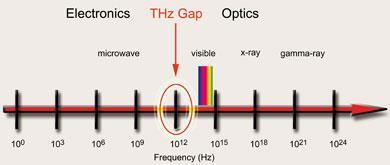
With outer limits generally taken to be 300GHz to 10THz (10 × 1012 Hz), THz radiation corresponds to a wavelength range between about 1 and 0.03mm. At lower frequencies lies the electronic regime of millimetre or microwave radiation, used for applications such as wireless telecommunication. At higher frequencies lies the optical regime, where active optical devices like semiconductor lasers and light-emitting diodes generate near-infrared and visible light for fibre-optic transmission and data storage. Between these two worlds lies the THz technology gap, where conventional solid-state optical and electronic technologies simply don’t measure up. Until just a few years ago, generating and detecting THz radiation was extremely difficult, holding enormous promise yet tantalisingly out of reach.
THz radiation is non-ionising, so it’s safe to use on humans, yet it can penetrate many visually opaque materials. This makes it potentially useful in security scanning for concealed weapons, explosives, or biological agents such as anthrax. It interacts strongly with water but passes through a few millimetres of biological tissue, so can also be used for medical imaging, or to study the fundamentals of cellular and molecular biology.
It beats infrared light for resolving power because it suffers less Rayleigh scattering, imaging details less than 1 millimetre wide. And many molecular excitations, such as rotations and vibrations, lie in the THz range, which means that the same spectroscopic instruments could simultaneously investigate both the physical and chemical properties of a material.
Top of the wish list for researchers in the field are higher-power sources, more sensitive detectors, and a compact way to tune the radiation – technologies that will help to drive down the cost and complexity of THz spectroscopy and imaging systems. Steady progress is being reported on all of these building blocks, and it’s all being driven by advances in materials science.
My generation
Ultimately, THz technology is a numbers game: more power delivers smaller, cheaper THz imaging systems plus speedier data acquisition. An emerging technology called the quantum-cascade laser (QCL) is tipped to play a central role in next-generation THz imaging and spectroscopic systems. The European Union TeraNova R&D programme, for example, is carrying out intensive evaluation work on QCL THz generation schemes.
’In these devices, we rely on the quantum mechanics of low-dimensional structures to provide energy levels for lasing action,’ explains TeraNova project lead Martyn Chamberlain from the University of Durham, UK.
The most common lasers, found in anything from supermarket bar code readers to CD players, rely on semiconductor crystals with a specific energy between their conduction and valence bands. An electron falling from one to the other emits a single photon of a specific frequency that is entirely dependent on this band gap.
But QCL lasers instead contain alternating layers of two different types of semiconductor. As an electron travels through the crystals, it steps through these layers like a ball rolling down a terraced hill, emitting a photon at each level. The thickness of the layer, as well as the chemical composition of the semiconductor, determines the wavelength of these photons, making it much easier to tune the device to emit a certain frequency. Scientists took their first step in 2002, by building a QCL that produced intense radiation at 4.4 THz.
Chamberlain says that the main challenges now facing the TeraNova partners are to make the devices work at lower frequencies (1THz is the goal); to make the devices work at sensible temperatures where cryogenic cooling is not needed; and to extract the radiation efficiently from the devices.
While these systems are able to generate a continuous stream of radiation that could produce real-time imaging movies, being able to generate a series of THz pulses could also be useful. Terahertz time-domain spectroscopy uses incredibly short bursts of radiation, each just picoseconds (10–12 s) in duration. This can pick out the unique spectral fingerprint of materials such as explosives or narcotics, and has clear potential in security scanning systems.
Pulsed THz devices were made possible by the realisation of ultrashort-pulse lasers in the early 1990s - a breakthrough that allows routine generation of stable optical pulses of the order of 10 fs (10 × 10–15 s). These pulses from a near-infrared laser are directed onto a suitable photoconverter, such as a gallium arsenide or zinc telluride semiconductor, which then stimulates THz output from the material.
Arno Schneider and colleagues at ETH Zürich, Switzerland, are among the leading pioneers of this approach to broadband THz generation. But rather than using conventional inorganic semiconductors to convert optical into THz pulses, the multidisciplinary team – physicists, materials scientists and chemists – is focusing its efforts on an organic crystalline salt called 4-N,N’ -dimethylamino-4’-N’ -methylstilbazolium tosylate. More conveniently known as DAST, the material is being commercialised by a spin-out company called Rainbow Photonics (also based in Zürich), selling DAST crystals to the THz research community and to industry.
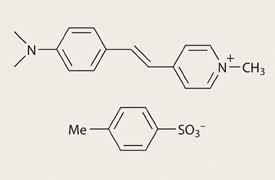
DAST crystals are grown from a supersaturated solution in methanol, seed crystals forming as the solution temperature is lowered. For large, high-quality crystals, this process can take up to two months. The key to high quality is precise control over the temperature. ’The growth, and particularly the temperature control, are in principle automated, but inspected occasionally,’ says Schneider. ’The process is scalable in the sense that Rainbow Photonics is running several growth vessels in parallel.’
Schneider claims there are several advantages to using electro-optic crystals such as DAST. For starters, it can produce THz bandwidths of up to 20THz, much broader than standard semiconductors can produce. What’s more, owing to the interplay between optical and THz waves, the THz spectrum from DAST can be tuned to a certain degree. Using DAST crystals makes it easier to turn up the power of the system without causing damage to the material.
The only drawback of DAST is a gap in the spectrum between 0.9 and 1.3THz. ’The chemists and material scientists in our group are currently working on chemical modifications,’ says Schneider, aiming to obtain a broader gap-free spectrum. ’We have the first encouraging results, but the work is still in progress,’ he says. Ultimately, this highlights another reason to develop an organic system: tunability.
Nanostructures and metamaterials
Existing THz detection devices are not ideal for routine application. They’re either cryogenically cooled or have rotten sensitivity, while poor frequency control makes rapid spectroscopic imaging difficult. The answer, according to Andrea Markelz at the University of Buffalo, New York, US, could be in III-V active nanostructures – mainly based on indium arsenide (InAs) and gallium arsenide (GaAs). Markelz and her Buffalo colleague Jonathan Bird are part of a consortium that recently secured a four-year, $1.2 million grant under the US National Science Foundation Nanoscale interdisciplinary research teams (NIRT) initiative.
III-V nanostructures confine electrical charges to distinct energy levels that are separated by just the right amount for excitations and emissions to match the THz range. By controlling the size of the nanostructures, and varying the voltage across the devices, it’s possible to reach a wide range of THz frequencies. What’s more, since the detectors are readily integrated with standard electronics, an array with accompanying interconnects can be made on a single wafer.
THz modulation techniques have traditionally lagged advances in generation and detection, but researchers are beginning to see early success with metamaterials. The properties of metamaterials are determined by both their chemical and physical characteristics. These can be tailored to produce unusual electromagnetic properties, such as having a negative refractive index, which cannot be obtained in naturally occurring materials.
In November 2006, Hou-Tong Chen from Los Alamos National Laboratory in New Mexico, US, and colleagues published details of a metamaterial device capable of real-time control and manipulation of THz radiation at room temperature. It is made up of an array of gold, split-ring electric resonator elements fabricated on a semiconductor substrate (n-type GaAs grown on a semi-insulating GaAs wafer). The properties of the material can be switched electrically, which in turn can change the amplitude of the THz radiation by up to 50%, an order of magnitude better than existing modulators.
Off to market
While materials scientists report encouraging progress on THz functional components, the long-term payback on all that development effort hinges on successful technology transfer and product innovation.
The TeraNova programme is at the forefront of this effort. The four-year pan-European collaboration started in September 2004 with a remit that cuts across industry, academia and government laboratories, developing components, basic science, first-stage feasibility and system prototypes.
It hopes that security screening will be vastly improved by THz technology, which can detect concealed objects and distinguish metals from plastics. For now, TeraNova is concentrating on basic spectroscopy of materials of biomolecular and security interest as well as the effects of scattering of THz radiation in powders and clothing. Get the fundamental understanding right, argues Chamberlain, and from that will follow properly designed security systems.
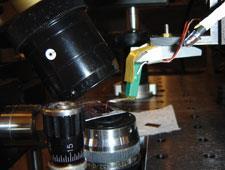
In other project areas, TeraNova has also realised two prototype THz systems that are ready for further development by industry. The first, a THz microscope, is being developed by Paul Planken and colleagues at TU Delft in the Netherlands. The aim is to unlock the properties of materials, including living materials, at THz frequencies.
The set-up employs a gallium phosphide (GaP) crystal as a detector of THz radiation. In addition to the incoming THz beam, the crystal is also irradiated with short pulses of near-infrared light. ’By moving a tip across the sample, which is placed on top of the GaP crystal, he can inspect small areas of the sample,’ explains Chamberlain. ’So far, he has achieved a spatial resolution better than 10 microns and has observed genuine spectroscopic features.’
Another notable TeraNova breakthrough is a biosensor that has the potential to recognise genetic mutations. The technology is being pioneered by Peter Haring and his team at the University of Siegen, Germany. Since THz radiation is sensitive to the movement of groups of molecules, it can detect the motion of the bases in DNA as they wobble and twist at THz frequencies. If there is a mutation present, owing to a misordering of the base sequence or because of an additional chemical, then some change in the THz absorption can be expected. This in turn translates into a change in frequency of a resonator in the biochip.
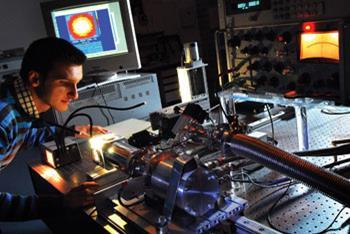
Among the TeraNova consortium members is TeraView, a UK manufacturer at the forefront of THz commercialisation efforts. TeraView was spun out of Toshiba Research Europe in April 2001 by co-founders Sir Michael Pepper and Don Arnone, both physicists at the University of Cambridge. The company, which is based in Cambridge and maintains strong links with the university, combines expertise in THz generation, detection and manipulation with a systems business that’s focused squarely on emerging applications of THz technology.
With this in mind, TeraView’s THz imaging system can be configured as a scanner with a fixed aperture, a more mobile probe device, or a terahertz spectrometer.
Last year, TeraView showed in a small trial that its technology could be used to assess suspect breast tissue removed during surgery. ’We found that terahertz light could reliably distinguish between normal breast tissue, tumour and even early-stage in situ cancers in excised tissue samples,’ says Vincent Wallace of TeraView, who worked with Addenbrooke’s Hospital in Cambridge on the study. Checking tissue in this way provided a reliable way to ensure the margins of the removed tissue were clear of cancer, potentially eliminating the need for multiple surgeries. Excised tissue is normally checked in a pathology laboratory, which can take several days - but with a THz instrument, a surgeon could immediately investigate the tissue they have just removed in the operating theatre, the team suggest.
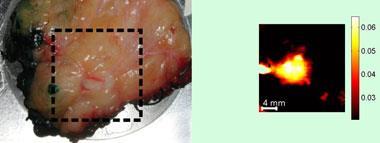
Other researchers have already proved that THz systems can detect illicit drugs. Chi-Kuang Sun and colleagues from the National Taiwan University in Taipei have developed a THz biochip that can distinguish between traces of powdered cocaine, amphetamine, potato starch, flour and lactose in less than five seconds.
TeraView is also focusing on THz applications in the pharmaceutical industry. It hopes that THz imaging and spectroscopy could help to improve the integrity and performance of drug tablets and aid the discovery of new polymorphs. More generally, THz scanners can provide information on hydration states and crystallinity of both organic and inorganic materials.
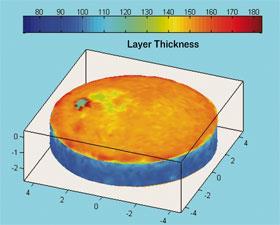
So it looks as though THz technology is already coming full circle. As scientists fine-tune the chemistry of their semiconductor materials to generate, detect and control THz radiation with greater precision, the devices they create are already providing new spectroscopic methods for materials science.
Joe McEntee is a science and technology writer based in Bristol, UK
Companies involved
-
Alpes Lasers is a spin-off from the University of Neuchâtel, Switzerland. It was founded by Jerome Faist, co-inventor of the quantum cascade laser (QCL). The company sells a range of QCL terahertz (THz) systems.
-
Picometrix, part of Advanced Photonix,California, US, develops and manufactures ultra high speed photoreceivers and instrumentation. In 1999 it introduced the world’s first commercial THz instrument: its T-Ray 2000.
-
Microtech Instruments, based in Oregon, US, sells a range of THz spectrometers, generators, detectors, lenses and windows, and polarisers
-
TeraView, Cambridge, UK, makes 3D imaging and spectroscopic systems that exploit the properties of THz radiation to characterise materials. The company was spun out of Toshiba in 2001. Products include its TPS Spectra 1000, a THz transmission spectrometer, and the TPI Imaga 1000, a THz imaging system.
-
Thales is an international electronics and systems group serving the defence, aerospace and security markets, based in France. It is working on generating high spectral purity tunable THz signals for applications in biochemical monitoring in security systems.
-
Thomas Keating Instruments, Billingshurst, UK, designs and develops quasi-optical THz systems. Its THz products include THz antennae and THz radar adsorbing material tiles.
-
Bruker Optics, part of Bruker Biosciences, US, together with TeraView, UK, sells a THz pulsed imaging (TPI) spectrometer system. The TPI Spectra 1000 determines chemical composition as well as the structural features of a sample.
Additional information
- The terahertz gap: the generation of far-infrared radiation and its applications. Special issue of Phil. Trans. R. Soc. Lond. A, 2004, 362, 197
- R Köhler et al, Nature, 2002, 417, 156 (DOI: 10.1038/417156a)
- A Schneider et al, Opt. Express, 2006, 14, 5376 (DOI: 10.1364/OE.14.005376)


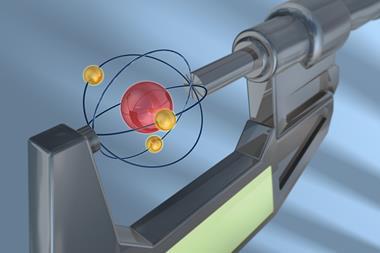

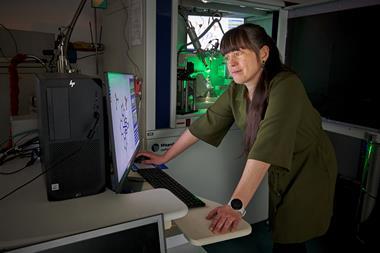







No comments yet